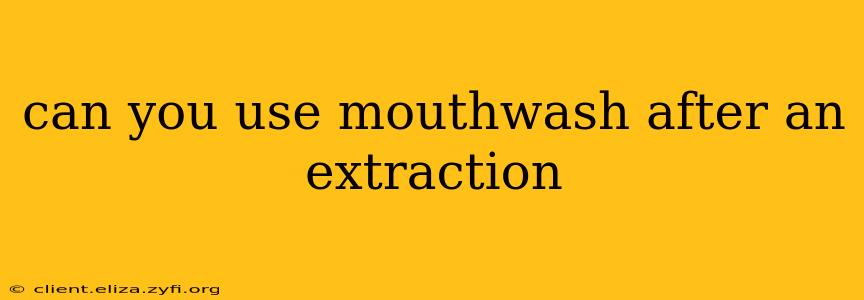Can You Use Mouthwash After an Extraction? A Comprehensive Guide
The question of whether or not you can use mouthwash after a tooth extraction is a common one, and the answer isn't a simple yes or no. While mouthwash can be a helpful part of your oral hygiene routine, its use after an extraction requires careful consideration. Using the wrong type of mouthwash or using it incorrectly can significantly hinder the healing process and even lead to complications. This guide will explore the nuances of mouthwash use post-extraction, providing you with the information you need to make informed decisions about your oral care.
What Happens After a Tooth Extraction?
Understanding the post-extraction healing process is crucial. After a tooth is extracted, a blood clot forms in the socket. This clot is vital for preventing infection and promoting healing. The socket then gradually fills with new bone and tissue over several weeks. Anything that disrupts this delicate process can impede healing and increase the risk of complications like dry socket (alveolar osteitis), a painful condition where the blood clot is lost.
Can I Use Mouthwash Immediately After an Extraction?
No. It's generally recommended to avoid using any type of mouthwash for at least 24 hours after an extraction. The initial 24 hours are critical for blood clot formation. The force of rinsing with mouthwash, even a gentle rinse, can dislodge the clot.
What Kind of Mouthwash is Safe to Use After an Extraction?
Once the initial 24-hour period has passed, you may be able to use a mild, alcohol-free mouthwash. Alcohol-based mouthwashes are strongly discouraged as the alcohol can irritate the extraction site and hinder healing. Always check the ingredients list to ensure the mouthwash is alcohol-free. Look for mouthwashes specifically designed for sensitive gums or those containing antiseptic agents like chlorhexidine.
How Should I Use Mouthwash After an Extraction?
If your dentist approves the use of mouthwash, follow these guidelines:
- Gentle Rinsing: Avoid forceful rinsing or swishing. Instead, gently swish a small amount of mouthwash around your mouth, being careful not to direct the flow directly onto the extraction site.
- Short Rinses: Keep the rinsing time short, no more than 30 seconds.
- Dilute the Mouthwash: Consider diluting the mouthwash with an equal amount of water to further reduce its potency and minimize irritation.
- Frequency: Rinse only a couple of times a day, as excessive rinsing can also disrupt the healing process.
What If I Develop Dry Socket?
Dry socket is a painful complication that can occur if the blood clot is dislodged from the extraction site. Symptoms include intense pain, a bad odor, and a visible empty socket. If you suspect you have dry socket, contact your dentist immediately. They can provide treatment to alleviate the pain and promote healing.
Are There Alternatives to Mouthwash for Oral Hygiene After Extraction?
Yes! Maintaining good oral hygiene is crucial after an extraction, but it doesn't always require mouthwash. Here are some alternatives:
- Saltwater Rinses: Saltwater rinses are a gentle and effective way to clean the mouth and promote healing. Dissolve ½ to ¾ teaspoon of salt in a glass of warm water and rinse gently several times a day.
- Soft-Bristled Brush: Use a soft-bristled toothbrush and gently brush your teeth, avoiding the extraction site.
When Should I Consult My Dentist?
Always consult your dentist or oral surgeon before using any mouthwash after an extraction. They can advise you on the best approach based on your individual circumstances and the type of extraction performed. Contact your dentist immediately if you experience any signs of infection, such as severe pain, swelling, fever, or excessive bleeding.
This information is for general knowledge and does not constitute medical advice. Always consult with your dentist or oral surgeon for personalized guidance regarding your post-extraction care.
